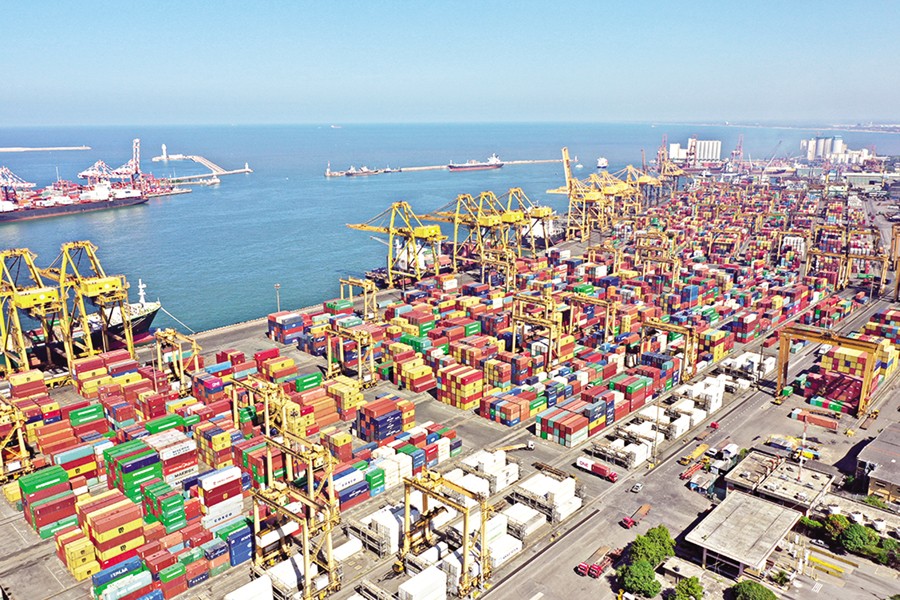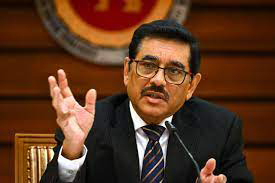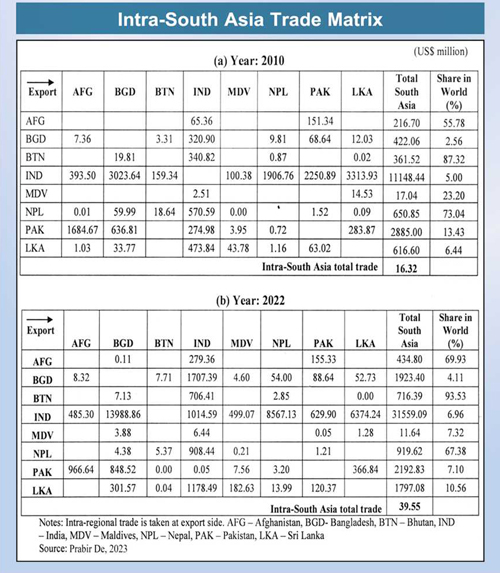 Colombo Sea Port in Sri Lanka is an important international trading hub in South Asia —Collected Photo
Colombo Sea Port in Sri Lanka is an important international trading hub in South Asia —Collected Photo 
The global economy has faced several challenges in recent years. While Covid-19 took a substantial socioeconomic toll on the global economy as it emerged and spread, it also created several new vulnerabilities in economies while also exposing several deep-rooted issues, as we have seen from the experience of the Sri Lankan economy. With the rapid deployment of vaccines and economies adjusting to the 'new normal' of Covid-19, the global economy has seen a new turn of events caused by emergences of geopolitical tensions that are having sustained impact on commodity prices and with the possibility of negative impacts on commodity availability.
On account of these developments, although global output growth is expected to continue slowing down, the South Asian region is expected to display some resilience especially on account of exports and continued flow of remittances. However, in all South Asian economies, projected growth may be teetering around the average seen prior to the pandemic, without reaching the same. This is primarily due to the unwinding of the expansive monetary and fiscal loosening that was needed in the wake of the pandemic. Contrary to our optimism as individual economies, as a region, we need to be wary of this modest growth pace as all of us are striving to take our economies to the 'high-income' category within the next few decades, i.e. at least within a generation. Hence, there is an urgent need to rethink areas of synergies and find means and ways of converging and reaching consensuses so that as policymakers and policy practitioners we can pave the way for prosperous economies and societies.
Amid the global economic slowdown, the South Asian Association of Regional Cooperation (SAARC) bloc will need to go back to the drawing board and rapidly work out effective yet pragmatic strategies that can help our vulnerable region to weather this storm. Regionalism will be essential to sustain South Asia's dynamism. South Asia is a sub-region that is yet to fully exploit its intra-regional potential. With one of the world's largest markets and a growing superpower in our neighbourhood, i.e., India, enhancing regional economic cooperation can not only ensure better growth prospects for our individual economies but can also enable the devising of effective responses to several long-standing developmental challenges. I also wish to acknowledge that it is not a simple bloc in that each of the member states has diverse characteristics and possess somewhat differing views and statuses in relation to infrastructure, population, technological development and especially in relation to political influence and military power. It may be appropriate to say that South Asia comprises several nations, but it is not small. After all, today, the South Asia region is home to two billion inhabitants which is 25 per cent of the global population.
Despite these differences, let us take a moment to go back to our roots which are intertwined in terms of culture, ethnicity and religion. There are several cross-border similarities in traditions, languages and customs. Hence, it may be appropriate to go the next mile and also adopt the 'South Asian' identity. On the basis of such a common identity, deriving synergies in the areas of intraregional trade, investment flows, transport and connectivity, financial integration and even across developmental issues of food security and climate change and mitigation can enable the overall upliftment of our member nations, as a first-round effect, while also improving the region's preparedness to participate in and benefit from broader regionalism in the Asia and Pacific region.

INTRAREGIONAL TRADE: Intraregional trade among SAARC nations is crucial for promoting economic growth and reducing poverty in the region. However, trade within SAARC has historically been limited due to various factors, including political tensions, restrictive tariffs and duties, import restraints, protracted customs requirements, and excessive documentation.
Sri Lanka's exports to the SAARC region accounted for nearly 10 per cent of total Sri Lankan exports while import expenditure accounted for nearly 29 per cent of total expenditure due to significantly high imports (about 89 per cent in 2022) from India. Intra-regional trade among SAARC countries was about US$40 billion (in each direction) in 2022, which has seen a steady growth over the years compared to US$ 6 billion in 2003. Imports among SAARC countries were about 4 per cent of the total imports from the world by SAARC Countries while exports among SAARC countries were about 7 per cent of the total exports to the world by SAARC Countries, which indicates that despite steady growth in regional trade it is still limited compared to total trade of the region1.
Needless to say, over time there have been several measures taken to improve intraregional trade through preferential trade agreements such as the SAARC Preferential Trade Arrangement (SAPTA) from 1995 and the South Asian Free Trade Area (SAFTA) since 2006. These agreements could have been partially responsible for the steady growth in regional exports although there are obstacles to further improving trade. In addition to the above, the Asia Pacific Trade Agreement (APTA) and Global System of Trade Preferences (GSTP) also cover some of the SAARC countries. However, overall, export potential of the region is straddled by low product coverage, similarity of product baskets and rigid non-tariff measures. Hence, it is essential to continue efforts to strengthen trade ties with regional peers to effectively execute existing regional agreements, while essentially exploring possible entry to new and broader regional partnerships, such as Regional Comprehensive Economic Partnership (RCEP).
Several other agreements such as the Bay of Bengal Initiative for Multi-Sectoral Technical and Economic Cooperation (BIMSTEC), Indian Ocean Rim Association (IORA) are in operation to improve regional economic partnership while the SAARC Agreement on Trade in Service (SATIS) is being negotiated to cover trade in services sector in the region.
Another welcome initiative has been the recent scheme by India to trade in Indian rupees. This is expected to create more avenues for trade and trade integration within the region by reducing the exposure on US dollar and other reserve currencies. It may also be appropriate to assess the possibility to expand such initiatives to the South Asia region as a whole, to expand trade settlement by South Asian countries in local currencies. I believe a collaborative study in this regard is to be initiated shortly as part of research collaboration under SAARC Finance and I sincerely hope that there will be some positive and material findings that can help pave the way for such integration.
Amid initiatives to enter into new trade agreements, I believe the prudent way forward is to partake in the 'global village' by identifying means of integration with global/regional value chains and diversification of exported goods, while broadening the export market in general. Nevertheless, rather than relying too much on duty concessions, export promotion policies need to focus on exporting improved quality goods with high value addition at lower costs of production, achieved through research and development led innovation, over the medium to long term.
The similarity of export product basket in the region could help improve production networks in the region as well, thereby regional economies could benefit through cooperation than competition. In order to succeed in this, it is required to reduce overall tariff and non-tariff barriers in the region in general. The benefits of such cooperation could extend towards services exports as well, which for most countries is an untapped opportunity. For example, the regional countries could benefit from cooperation in tourism, IT/BPO, transport, health, education and professional services sectors.
TRANSPORT: The South Asian region is strategically located between Europe and Southeast Asia. Asia itself is the world's leading maritime cargo handling centre in 2021, accounting for 42 per cent of exports and 64 per cent of imports and around 40 per cent of total containerized trade was on the main East-West route.
Despite our strategic location only three of the region's ports, two of which are in India and the Colombo Port are in the top 50 container ports. Port performance is not only about enhancing regional connectivity but also has direct implications on the competitiveness of our region's exports and thereby our ability to further penetrate the EU and fast-growing ASEAN market.
With the growing traction for a 'global village,' the time is opportune for us to consider means in which we can improve cross-border connectivity while also ensuring our sovereignty and security. Although several strides have been made in relation to transport infrastructure and services within individual member nations, cross-border transport facilitation is almost non-existent.
Enhanced intra-regional connectivity can open up a myriad of opportunities to establish regional production networks and develop value chains that enable the exploitation of individual countries' abilities to create highly competitive final products. This can help create regional synergies that will enhance access to global markets through improved productive capacity. In turn, this can be expected to translate into balanced regional development. Linking inland manufacturing and production centers that are scattered across the region can also be a game-changer in fostering intraregional trade.
ENERGY: Another area of cooperation that can immensely benefit all nations is in relation to the energy sector. While the SAARC region had been grappling with energy constraints on account of insufficient energy resource endowments, bottlenecks in domestic energy infrastructure and lack of investment mobilization in the energy sector, the region is now presented with new challenges in light of the need to transition away from fossil fuels, in line with the Sustainable Development Goals Agenda of 2030.
Studies show that in all South Asian countries except India, pollution-intensive jobs far exceed green jobs and account for 6- 11 per cent of all jobs. Such jobs are also concentrated among lower-skilled and informal workers. Regional cooperation in areas of education, training and even market access can help mitigate these inevitable losses by improving labour mobility to green sectors.
On the other hand, regional cooperation can also help facilitate investment and technical assistance flows that can enable the smooth transition to renewables as seen in the experience of Sri Lanka which is benefiting from India's investment and expertise in this area.
There is plenty of potential for cooperation also in relation to energy resource exploration and management. While there have been strides in energy trade projects, these have usually been between a few selected countries and have not addressed the region as a whole. With our economies being vulnerable to the spillover effects of global energy price shocks, this may be an opportune moment to assess how to develop a sub-regional grid building on existing interconnections while also creating a formal mechanism to share good practices in enhancing energy efficiency and renewable technologies.
INFORMATION AND COMMUNICATION TECHNOLOGY: In the last decade, our sub-region has made significant progress in the Information and Communication Technology (ICT) sector, positioning itself as a major production hub and a highly sought after exporter of IT and IT-enabled services. Covid-19, of course, helped catalyse a significant portion of the recent transformation.
Even then, progress across the region is uneven and there are growing disparities in access to technology even within countries.
As in the case of energy, investing in cross-border IT and telecommunications infrastructure to improve the overall infrastructure base in the region is becoming increasingly important especially considering its potential to build and protect existing human capital; create jobs and innovation and empower human capital to enable economies to sustain growth and meet SDG targets.
Facilitating cooperation in this area is imperative to improve the resilience of the region, especially in the face of new shocks such as climate disasters, pandemics and even technology-induced disruptions in employment.
FINANCIAL COOPERATION: From a macroeconomic perspective, in recent times, Sri Lanka has immensely benefited from its SAARC peers, particularly India and Bangladesh. The assistance that was extended in the wake of the crisis provided immense relief in the midst of the socioeconomic quagmire that Sri Lanka was in.
This type of financial cooperation among us can not only be a short-term buffer but it can also be of a more long-term nature in the form of investment flows towards infrastructure gaps and even building of overall productive capacities.
Several commendable initiatives are already in place, such as the SAARC Finance and the SAARC Public Debt Managers' Forum which offers platforms for discussions in relation to financial flows and to facilitate overall congruence in policymaking.
ADDRESSING OTHER SOCIAL VULNERABILITIES: South Asia is a hotspot for natural calamities and therefore its population of 2 billion people is becoming increasingly vulnerable to the impacts of climate change, food insecurity and infrastructure devastation. Given such common risks and vulnerabilities across the region, collaboration in this regard is the only means of ensuring sustainable growth amid these natural shocks.
There is a collective need to improve agricultural productivity through sustainable agriculture practices. While certain member countries have made strong achievements in this regard, others continue to lag. Also considering that natural ecological systems go beyond our individual boundaries, pooling technology and information in a manner that focuses on sustainable management of natural resources for food security and agriculture productivity is imperative.
Greater regional cooperation can help minimise food price volatility and focus production systems to fill the lacuna that lies in demand and supply. In this regard, strengthening of existing regional institutions such as the SAARC Seed Bank and the SAARC Food Bank may be timely. Collaborations in relation to good agricultural practices, effective land use, crop productivity, food production, seed production, livestock rearing, and disease management can help spur innovation in a timely and effective manner.
The recent devastating floods in the region are a reminder of our region's vulnerability to climate change. For many of our individual economies, earmarking funds for climate change amid our macroeconomic vulnerabilities can be a daunting and challenging task. Mainstreaming disaster risk reduction through enhanced regional cooperation can help compensate financing gaps. A network of multi-hazard early warning systems established through the pooling of resources, expertise, knowledge and information can help address this key shared vulnerability while also enabling the channelling of knowledge about building resilient cities.
REFRAMING RELATIONSHIPS WITH THE GLOBAL ECONOMY: The trade barriers that are currently in place across each of our economies are also affecting our integration with the global economy.
There has been lot of focus among academia, researchers and policymakers about value chain activity gravitating towards India. This could catalyse the development of regional value chains and services trade involving the rest of South Asia. Accordingly, research highlights that several national and regional policies are required to pave the way for regional trade integration between South Asia and the rest of Asia. There is plenty of scope to streamline and slowly reduce trade barriers that will enable integration with our immediate neighbours and thereby evolving into linkages with the global economy.
Opening up trade will come with its own set of novel challenges which requires that we will also need to negotiate technical assistance and adjustment financing to smoothen the volatilities that may arise from these developments, especially among the smallest economies of our region.
From a broader perspective, increased cooperation, integration and alignment within the region can also help us to collectively benefit from inter-linkages in other major regional blocs such as ASEAN, among others.
Over the long run, emergence as a united sub-region can also enable tapping into multilateral funding and technical assistance as collaborative efforts which collectively benefit the region translates into efficacious fund utilisation that is often required by donors.
END NOTE: As has been discussed over the past three decades, i.e., since the establishment of SAARC, the South Asian region has consistently lagged other sub-regions and other regional blocs due to lack of integration. However, the region possesses immense potential in terms of its large population, rich resource endowment, geographical location and even common cultural heritage and historical roots. Going forward, to tackle the challenges presented by the volatile global environment and other novel and unique challenges such as climate change, pandemics and even technological disruption, forging linkages and identifying synergies amid the several differences is imperative and unavoidable to create sustainable growth for each of our economies and for the region to emerge as a growth driver.
Dr. Nandalal Weerasinghe, Governor of the Central Bank of
Sri Lanka. The piece is slightly abridged version of his speech delivered, as guest of honour, at the inaugural session of the Fourteenth South Asia Economic Summit (SAES XIV) in Dhaka on Saturday. www.saes14.cpd.org.bd
© 2024 - All Rights with The Financial Express
